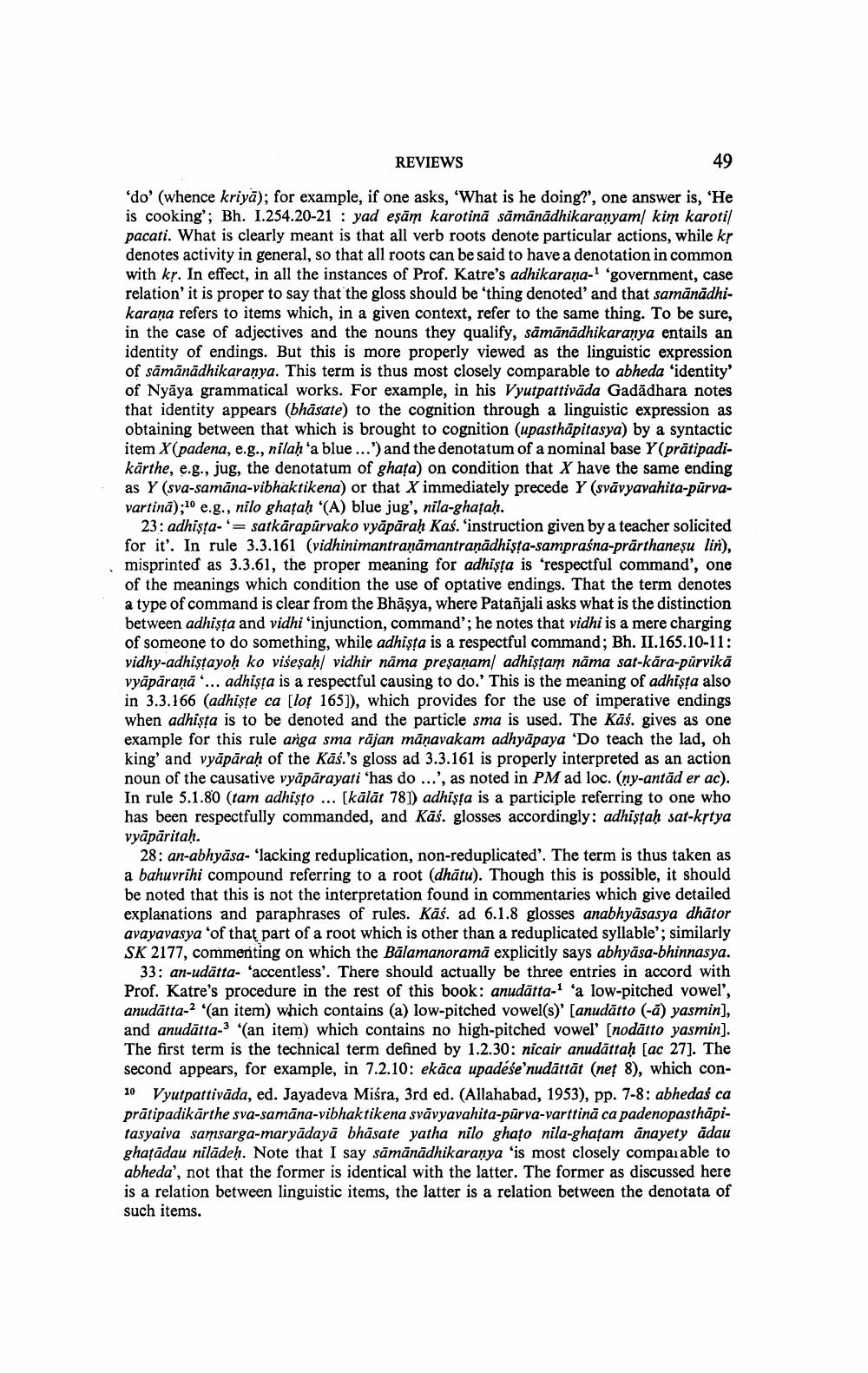Book Title: Reviews Of Different Books Author(s): Publisher: View full book textPage 7
________________ REVIEWS 'do' (whence kriya); for example, if one asks, 'What is he doing?', one answer is, 'He is cooking'; Bh. I.254.20-21 : yad esam karotina samanadhikaranyam/ kim karoti pacati. What is clearly meant is that all verb roots denote particular actions, while kr denotes activity in general, so that all roots can be said to have a denotation in common with kr. In effect, in all the instances of Prof. Katre's adhikarana-1 'government, case relation' it is proper to say that the gloss should be 'thing denoted' and that samanadhikarana refers to items which, in a given context, refer to the same thing. To be sure, in the case of adjectives and the nouns they qualify, samanadhikaranya entails an identity of endings. But this is more properly viewed as the linguistic expression of samanadhikaranya. This term is thus most closely comparable to abheda 'identity of Nyaya grammatical works. For example, in his Vyutpattivada Gadadhara notes that identity appears (bhasate) to the cognition through a linguistic expression as obtaining between that which is brought to cognition (upasthapitasya) by a syntactic item X(padena, e.g., nilah'a blue ...') and the denotatum of a nominal base Y (pratipadikarthe, e.g., jug, the denotatum of ghata) on condition that X have the same ending as Y (sva-samana-vibhaktikena) or that X immediately precede Y (svavyavahita-purvavartina);10 e.g., nilo ghatah (A) blue jug', nila-ghatah. 23: adhista-'=satkarapurvako vyaparah Kas. 'instruction given by a teacher solicited for it'. In rule 3.3.161 (vidhinimantranamantranadhista-samprasna-prarthanesu lir), misprinted as 3.3.61, the proper meaning for adhista is 'respectful command', one of the meanings which condition the use of optative endings. That the term denotes a type of command is clear from the Bhasya, where Patanjali asks what is the distinction between adhista and vidhi 'injunction, command'; he notes that vidhi is a mere charging of someone to do something, while adhista is a respectful command; Bh. II.165.10-11: vidhy-adhistayoh ko visesah, vidhir nama presanam adhistam nama sat-kara-purvika vyaparana ... adhista is a respectful causing to do.' This is the meaning of adhista also in 3.3.166 (adhiste ca [lot 165]), which provides for the use of imperative endings when adhista is to be denoted and the particle sma is used. The Kas. gives as one example for this rule arga sma rajan manavakam adhyapaya 'Do teach the lad, oh king' and vyaparah of the Kas.'s gloss ad 3.3.161 is properly interpreted as an action noun of the causative vyaparayati 'has do ...', as noted in PM ad loc. (ny-antad er ac). In rule 5.1.80 (tam adhisto ... [kalat 78]) adhista is a participle referring to one who has been respectfully commanded, and Kas. glosses accordingly: adhistah sat-krtya vyaparitah. 28: an-abhyasa- 'lacking reduplication, non-reduplicated'. The term is thus taken as a bahuvrihi compound referring to a root (dhatu). Though this is possible, it should be noted that this is not the interpretation found in commentaries which give detailed explanations and paraphrases of rules. Kas. ad 6.1.8 glosses anabhyasasya dhator avayavasya 'of that part of a root which is other than a reduplicated syllable'; similarly SK 2177, commenting on which the Balamanorama explicitly says abhyasa-bhinnasya. 33: an-udatta- 'accentless'. There should actually be three entries in accord with Prof. Katre's procedure in the rest of this book: anudatta-1 'a low-pitched vowel', anudatta-2 '(an item) which contains (a) low-pitched vowel(s)' [anudatto (-a) yasmin), and anudatta-3 (an item) which contains no high-pitched vowel' [nodatto yasmin). The first term is the technical term defined by 1.2.30: nicair anudattah [ac 27). The second appears, for example, in 7.2.10: ekaca upadese'nudattat (net 8), which con10 Vyutpattivada, ed. Jayadeva Misra, 3rd ed. (Allahabad, 1953), pp. 7-8: abhedas ca pratipadikarthe sva-samana-vibhaktikena svavyavahita-purva-varttina сa padenopasthapitasyaiva samsarga-maryadaya bhasate yatha nilo ghato nila-ghatam anayety adau ghatadau niladeu. Note that I say samanadhikaranya 'is most closely comparable to abheda', not that the former is identical with the latter. The former as discussed here is a relation between linguistic items, the latter is a relation between the denotata of such items.Page Navigation
1 ... 5 6 7 8 9 10 11 12 13 14 15 16 17 18 19 20 21 22 23 24 25 26 27 28 29 30 31 32 33 34 35 36 37 38
